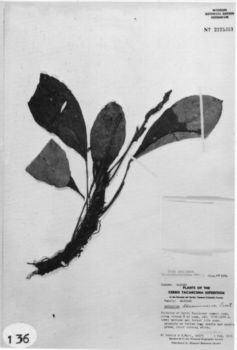




Anthurium tacarcunense Croat, sp. nov.
TYPE:Panama. Darien: Cerro Tacarcuna; along stream N of summit camp, 1,550-1,650 m, lower montane wet forest life zone. Gentry & Mori 14075 (MO 2275353, holotype; PMA, isotype).
Planta plerumque epiphytica, interdum terrestris;cataphyllum persistens fibris, apice interdum intactum; petiolus teres, 7-14 cm longus; lamina oblanceolata, siccitate modice coriacea, basi anguste acuta ad attenuata, utrinque glanduloso-punctata, 10.5-19 cm longa, 4.2-7.3 cm lata; inflorescentia erecta; pedunculus 7-17 cm longus, teres aut raro tricostatus; spatha modice membranacea viridis, lanceolata, 2.5÷4.3 cm longa, 5-10 mm lata; spadix viridis, 5-7 cm longus; baccae albae, ovoido-ellipsoideae, 1.8-2.2 mm longae.
Usually epiphytic, sometimes terrestrial, 35-45 cm tall; stem to 20 cm long, 8-10 mm diam.; roots numerous, 2-3 mm diam., descending; cataphylls narrowly triangular, 2.5-4 cm long, acute to narrowly rounded at apex with short subapical apiculum, drying reddish brown, weathering to persistent fibers, sometimes more or less intact at apex.
LEAVES semierect; petioles 7-14 cm long, 2-3 mm diam., terete; geniculum 1-1.5 cm long; blades oblanceolate, drying moderately thick, obtuse at apex (acumen short and flat), narrowly acute to attenuate at base, 10.5-19 cm long, 4.2-7.3 cm wide; both surfaces se-miglossy, the upper surface inconspicuously glandular-punctate, the lower surface paler, glandular-punctate; midrib raised on both surfaces; primary lateral veins 8-12 per side, departing midrib at 40-50° angle, straight or weakly curved to collective vein, prominulus above and below (dry); interprimary veins drying only slightly less conspicuous than primary lateral veins; collective vein arising from the base, 3-5 mm from margin, scarcely visible above, prominulous below (dry).
INFLORESCENCE erect; peduncle 7-17 cm long, 2-3 mm diam., terete or rarely 3-ribbed; spathe moderately thin, green, lanceolate, 2.5-4.3 cm long, 5-10 mm wide, broadest just above the base, inserted at ca. 45° angle on the peduncle; spadix green, 5-7 cm long, 2.5-3.5 mm diam. at base, 2-2.5 mm diam. at apex; flowers rhombic, 2.8-3 mm long, 2-2.5 mm wide, 2-3 flowers visible m the principal spiral, 5-6 flowers visible in the alternate spiral; lateral te-pals 1.4-1.6 mm wide, the inner margins broadly rounded; pistils weakly emergent, green; stigmas oblong-elliptic, ca. 0.25 mm long; stamens retracting after anthesis; flowers drying thick and semi-intact.
INFRUCTESCENCE with spadix 8-9 cm long; berries white, subglobose, rounded at apex; mesocarp with whitish raphide cells in upper one-half of berry; seeds 2, greenish white, ovoid-ellipsoid, oblique at apex, rounded at base, 1.8-2.2 mm long, 1.2-1.4 mm wide, ca. 1 mm thick, enveloped in a sticky, gelatinous, transparent sac, thickest along one side and at ends. Fig. 136.
Anthurium tacarcunense is apparently endemic to Cerro Tacarcuna in Darien Province of Panama at 1,550 to 1,850 m, occurring in lower montane wet and elfin forest. It is naturally to be expected in adjacent Colombia.
The species is in section Porphyrochitonium and is recognized by its slender, densely rooted stems, its persistent, weathered cataphylls, its long-petiolate, oblanceolate, glandular-punctate leaves with the interprimary veins about equally as prominent as the primary lateral veins, and by its lanceolate spathe, slender green spadix, and white berries. It is closest to Anthurium terryae of the Serrania de Pirre, which shares a green spathe and white berries. The latter differs in having the primary lateral veins more remote from one another and lacking prominent interprimary veins. In addition A. terryae has stamens that remain exposed after anthesis and are exserted on dried specimens.
Folsom and Collins 6660 from the Serrania de Canasas is perhaps also this species, but the leaf blades lack the prominent interprimary veins. Another collection that has similar flowers is Hartman et al. 4639 from Cerro Pirre, but this collection has leaf blades similar to those of Anthurium crassitepalum, which are only scarcely broader toward the apex. The specimen has been placed provisionally in A. tacarcunense.

Darien: Cerro Tacareuna, Gentry & Mori 14029 (MO), 14075
(MO, PMA), Gentry el al. 16935 (COL, MO).
Panama: mountains of Torti Arriba, Folsom et al. 6660 (F, MO,
PMA, US).